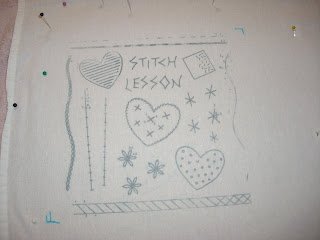Saturday morning. Ahhhh.
Fresh piping hot coffee from the Kuerig. With vanilla creamer.
New books from Sublime Stitching.
Virginal white dish towels.
What to do, what to do?
I had my first projects all planned out. But after receiving my order, I thought it would probably be a good idea to oh, i don't know, learn the stitches first.
There are so many great patterns I didn't know what I wanted to start with, which designs were worthy of my most awesome tea towel, at the same time wouldn't take so long that I'd become flustered and give up.
I decided to start out with the stitching samplers on flour sack dish towels. I made one for myself and one for Tweeny.
Take a moment to relax. Sip your coffee. Day dream about your gorgeously bitchin tattooed towels. The oohs and aaaahs from your friends. The wonderfully coveted gifts that you will give your loved ones with tags that say Hand Made with Love for You by Me.....
Fold the towel in the way that you will hang it for every day use. I pinned the pattern on and hung it on the stove to be sure that I was happy with the placement. Then I marked the corners with a water soluble pen for use on fabric.
Lay the scrap fabric down to protect your ironing board pad from overzealous transfer ink.
Remove the pattern and pins from your practice run.
Iron the towel to remove the wrinkles and prep the fabric. Make sure the steam setting is off (steam does not play nicely with the transferable ink), double check and that the iron is hot. After a couple of passes of the iron test the fabric with your hand to makes sure the cloth is very warm to the touch. Quickly place the pattern face-down just so on the fabric using your aforementioned corner marks.
I found it best at this point to just sort of press, or stamp with the iron. When I made a couple of passes over the pattern I found that either the pattern, the fabric or both tend to shift around just enough to blur the pattern.
On the 4th try I got the best results.
I pinned the fabric and scrap to the iron board cover so that both were securely in place.
I pressed down with the iron, leaving it in place for several seconds and then lifting it up, repositioning the iron and stamping it down again. Rinse and Repeat. Paying special attention to the corners and outlying edges, which tend to be the faintest lines because anything in the middle had been overlapped several times.
Try not to peak. I mean, you kind of have to at first. 'Cuz if you don't you may not get it dark enough. But once you peak, by very carefully lifting the corner of the transfer, pressing your face down next to the board, meticulously replace it, it's already been shifted just a hair. It's maddening.
Once you have done a practice transfer on a scrap cloth, you'll have an idea of how long it will take to get the lines darkened to your liking. You want them just dark enough to see, but not so dark that they are very thick or you'll be wasting the ink. Remember, these transfers are reusable, so don't over do it. You will most likely want to use them again and again.
Try it several times before you mark on your 'perfect' canvas with the 'one perfect' pattern.
This would be a great use for those patterns included in the book that you don't want or think you've got no use for. There was a lot of comments in the reviews about not wanting or having any use for the baby patterns. But there are so many good ones. I can hardly see how anyone could get to using them all. Anyway, my point is if there are a couple of patterns that fall into this category for you, use them by practicing your transferring skills. This is an important step along your path.
Can you see all of the overzealous transfer marks? That could be on your ironing board. Fair warning.
The samplers are a little tricky just because they are bigger patterns to begin with, so keep that in mind. Don't get too frustrated. Patience is a virtue, my friends. It won't be perfect the very first time. So just go with it. Remember that this is a hobby, and
Once you free yourself from the idea that it should be just-so, it's really quite satisfying to see your trasfer appear where just minutes ago, there was nothing. Viola!













0 comments:
Post a Comment